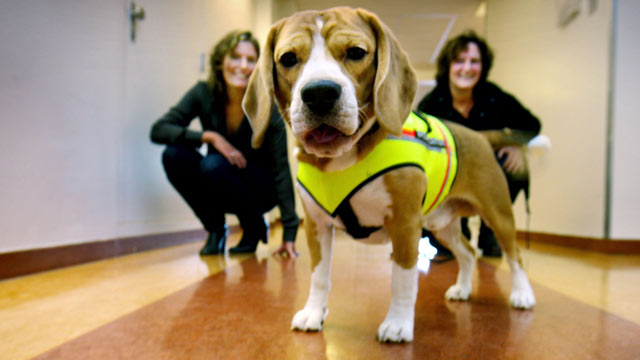In the future, pathologists and clinical laboratory administrators may need to plan for a canine addition to their traditional laboratory staff
See Cliff sniff C. diff! No, that’s not a line from a new reading primer. In fact, it refers to one hospital’s innovation for early detection of Clostridium difficile (C. diff): a two-year-old beagle named Cliff. Cliff the Beagle is faster at detecting certain infections than the standard clinical laboratory tests used daily in hospitals throughout the world.
Researchers from Vrije University Medical Center (VUMC) in Amsterdam successfully used the trained beagle to detect the smell of C. difficile in hospitals. The researchers believe trained canine disease detectives like Cliff could be a cheap and effective way to conduct routine C. diff screening in hospitals.
“In order to try to prevent transmission in your hospital, it’s important to recognize C. diff patients as early as possible,” stated Marije Bomers, M.D., the VUMC study’s lead author. She made the statement in an interview with Fox News, who reported the story. Bomers is a consultant internist and infectious disease specialist at VUMC. The study was published online in the British Medical Journal (BMJ).
Many types of healthcare-associated infections (HAIs) are on the decline. But according to a Centers for Disease Control and Prevention (CDC) website, C. diff remains at historically high levels in the United States. It causes diarrhea linked to 14,000 American deaths each year.
About 25% of C. diff infections first manifest as symptoms in hospital patients. The remaining 75% of C.diff infections first manifest symptoms in patients who recently received healthcare in other settings, including nursing homes. This disease results in at least $1 billion in extra health care costs annually, according to the CDC.
Canine Track Record Reveals High Sensitivity-Specificity Rates
Cliff has an impressive track record for detecting the C. diff “superbug” in both stool samples and the air surrounding patients in hospitals. In one test, Cliff was able to correctly identify 50 out of 50 stool samples that were C. diff positive. He correctly identified 47 of 50 negative samples. That’s a sensitivity rate of 100% and a specificity rate of 94%.

Here is Cliff, the beagle dog who uses his sense of smell to accurately detect C. diff in the environment or in a patient. An internal medicine specialist at Vrije University Medical Center in Amsterdam came up with the idea of training a dog to detect the superbug after recognizing that even human medical laboratory staff could detect the characteristic odor. She intends to broaden her trials using canine detectives in areas of high C. diff incidence. (Photo by ABC News)
Here is a video clip of Cliff the Beagle that shows how he detects Clostridium difficile infections using his sense of smell. (Video by the British Medical Journal.)
In another test, the canine sleuth was taken through two hospital wards. He correctly identified C. diff in 25 of 30 infected patients, a story published at webmd.com reported. He correctly identified no infection in 265 of 270 patients without the disease. And he went through the wards in just 10 minutes! According to a story published by Science Daily, that’s because the canine nose can detect a vast range of odors at concentrations down to parts per trillion!
Advantages over Existing Clinical Laboratory Testing Technologies
Canine diagnostics could have a number of advantages over more traditional testing methods. For one, time to answer can be quicker than conventional testing, allowing for earlier intervention to prevent spread of the disease. Further, although mechanical sniffers do exist, they require a sample, Bomers pointed out in a video clip at safepatientproject.org. Cliff can detect the bacterium from the air surrounding a patient’s bed.
Still, some remain skeptical about using diagnostic canines in healthcare settings such as hospitals and nursing homes. “I’m not sure I see this being deployed in an efficient way in a large hospital setting where there are many distractions,” stated Bruce E. Hirsch, M.D., infectious disease specialist at North Shore University Hospital in Manhasset, N.Y. He was quoted in the webmd story. On the other hand, Hirsch stated that he thinks the research is worth pursuing and pondered the potential for dogs to detect a broader range of diseases.
Fox News reported that Bomers would like to conduct additional research in hospitals with high incidence of C. diff—maybe in the United States. For pathologists and clinical laboratory managers, that may mean that—at some point—their medical laboratory staff may include air- and sample-sniffing pooches!
—Pamela Scherer McLeod
Related Information:
Dog trained to sniff out deadly C difficile superbug
Dog Sniff Out Deadly C. diff Infection




You’re a cutie, Cliff the C diff Doggie! Where was this dog when we needed him! A fecal transplant (FT) pretty much saved my uncle’s life. He had the C. diff colitis infection and was in progressive decline. About 3 days after the FT he started feeling normal again…. get the word out about this odd but safe option!
I was surprised to see that gloves were not worn by the laboratory worker. I guess they are not required in Amsterdam.